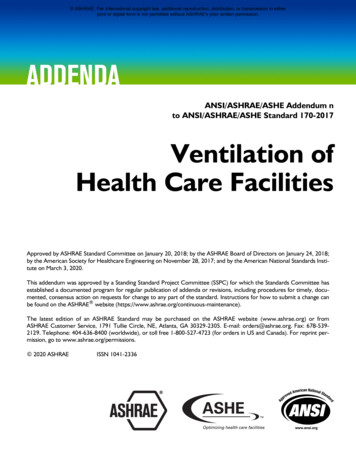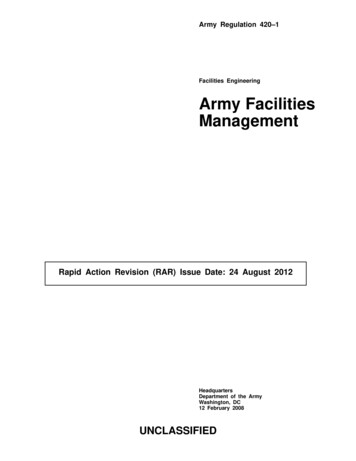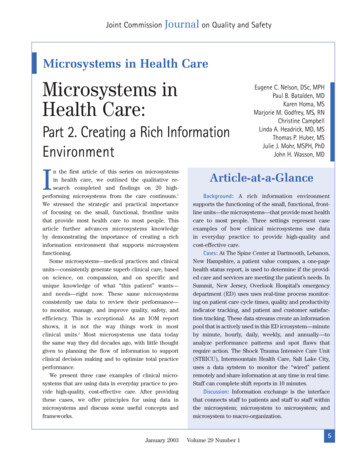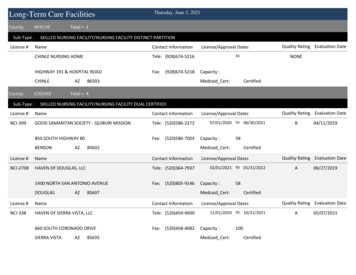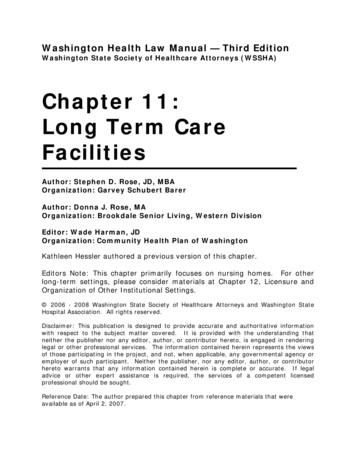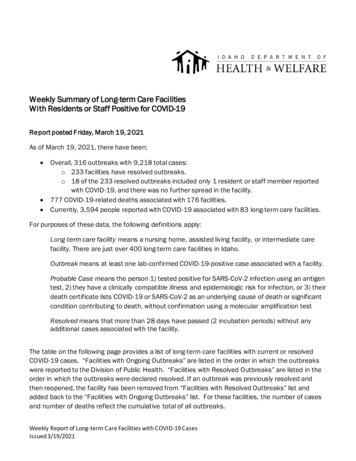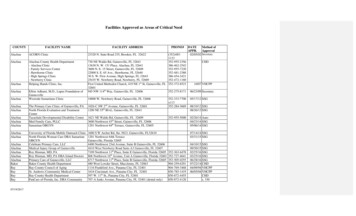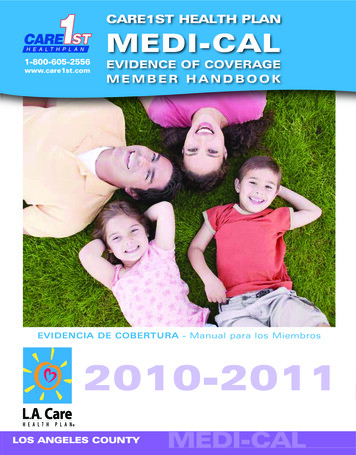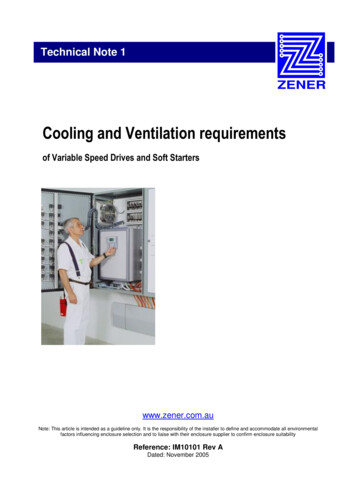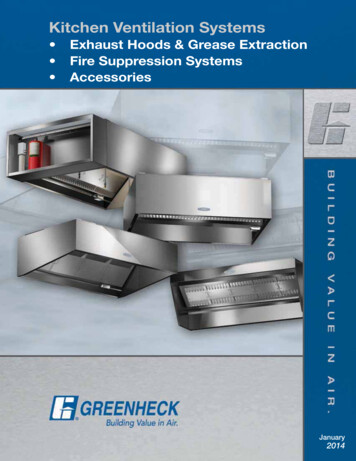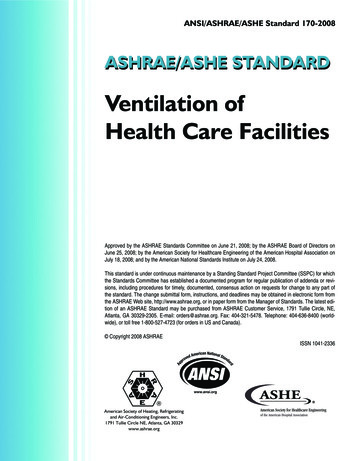
Transcription
ANSI/ASHRAE/ASHE Standard 170-2008ASHRAE/ASHE STANDARDVentilation ofHealth Care FacilitiesApproved by the ASHRAE Standards Committee on June 21, 2008; by the ASHRAE Board of Directors onJune 25, 2008; by the American Society for Healthcare Engineering of the American Hospital Association onJuly 18, 2008; and by the American National Standards Institute on July 24, 2008.This standard is under continuous maintenance by a Standing Standard Project Committee (SSPC) for whichthe Standards Committee has established a documented program for regular publication of addenda or revisions, including procedures for timely, documented, consensus action on requests for change to any part ofthe standard. The change submittal form, instructions, and deadlines may be obtained in electronic form fromthe ASHRAE Web site, http://www.ashrae.org, or in paper form from the Manager of Standards. The latest edition of an ASHRAE Standard may be purchased from ASHRAE Customer Service, 1791 Tullie Circle, NE,Atlanta, GA 30329-2305. E-mail: orders@ashrae.org. Fax: 404-321-5478. Telephone: 404-636-8400 (worldwide), or toll free 1-800-527-4723 (for orders in US and Canada). Copyright 2008 ASHRAEISSN 1041-2336American Society of Heating, Refrigeratingand Air-Conditioning Engineers, Inc.1791 Tullie Circle NE, Atlanta, GA 30329www.ashrae.org
ASHRAE Standing Standard Project Committee 170Cognizant TC: TC 9.6, Healthcare FacilitiesSPLS Liaison: H. Michael NewmanRichard D. Hermans, Chair*Peter Hogan Langowski*Paul T. Ninomura, Vice-Chair*Anand K. Seth*Michael F. Mamayek, Secretary*Rajendra N. Shah*Theodore Cohen*Dennis E. ShaughnessyGeorge A. FreemanMichael Patrick Sheerin*Gerald L. HendricksonRobert J. WeberMichael R. Keen*Michael E. Woolsey*William M. KingreyXudong YangMarvin L. Kloostra*Michael MayoFrederick H. Kohloss* Denotes members of voting status when the document was approved for publicationASHRAE STANDARDS COMMITTEE 2007–2008Nadar R. JayaramanStephen D. Kennedy, ChairByron W. JonesHugh F. Crowther, Vice-ChairJay A. KohlerRobert G. BakerJames D. LutzMichael F. BedaCarol E. MarriottDonald L. BrandtR. Michael MartinSteven T. BushbyMerle F. McBridePaul W. CabotFrank MyersKenneth W. CooperH. Michael NewmanSamuel D. Cummings, Jr.Lawrence J. SchoenK. William DeanBodh R. SubherwalRobert G. DoerrJerry W. White, Jr.Roger L. HedrickBjarne W. Olesen, BOD ExOEli P. Howard, IIILynn G. Bellenger, COFrank E. JakobClaire B. Ramspeck, Assistant Director of Technology for Standards and Special ProjectsSPECIAL NOTEThis American National Standard (ANS) is a national voluntary consensus standard developed under the auspices of the AmericanSociety of Heating, Refrigerating and Air-Conditioning Engineers (ASHRAE). Consensus is defined by the American National StandardsInstitute (ANSI), of which ASHRAE is a member and which has approved this standard as an ANS, as “substantial agreement reached bydirectly and materially affected interest categories. This signifies the concurrence of more than a simple majority, but not necessarily unanimity.Consensus requires that all views and objections be considered, and that an effort be made toward their resolution.” Compliance with thisstandard is voluntary until and unless a legal jurisdiction makes compliance mandatory through legislation.ASHRAE obtains consensus through participation of its national and international members, associated societies, and public review.ASHRAE Standards are prepared by a Project Committee appointed specifically for the purpose of writing the Standard. The ProjectCommittee Chair and Vice-Chair must be members of ASHRAE; while other committee members may or may not be ASHRAE members, allmust be technically qualified in the subject area of the Standard. Every effort is made to balance the concerned interests on all ProjectCommittees.The Assistant Director of Technology for Standards and Special Projects of ASHRAE should be contacted for:a. interpretation of the contents of this Standard,b. participation in the next review of the Standard,c. offering constructive criticism for improving the Standard, ord. permission to reprint portions of the Standard.DISCLAIMERASHRAE uses its best efforts to promulgate Standards and Guidelines for the benefit of the public in light of available information andaccepted industry practices. However, ASHRAE does not guarantee, certify, or assure the safety or performance of any products, components,or systems tested, installed, or operated in accordance with ASHRAE’s Standards or Guidelines or that any tests conducted under itsStandards or Guidelines will be nonhazardous or free from risk.ASHRAE INDUSTRIAL ADVERTISING POLICY ON STANDARDSASHRAE Standards and Guidelines are established to assist industry and the public by offering a uniform method of testing for ratingpurposes, by suggesting safe practices in designing and installing equipment, by providing proper definitions of this equipment, and by providingother information that may serve to guide the industry. The creation of ASHRAE Standards and Guidelines is determined by the need for them,and conformance to them is completely voluntary.In referring to this Standard or Guideline and in marking of equipment and in advertising, no claim shall be made, either stated or implied,that the product has been approved by ASHRAE.
CONTENTSANSI/ASHRAE/ASHE Standard 170-2008Ventilation of Health Care FacilitiesSECTIONPAGEForeword . 21 Purpose . 22 Scope . 23 Definitions. 24 Compliance. 35 Planning. 46 Systems and Equipment. 47 Space Ventilation. 68 Planning, Construction, and System Start Up . 119 Normative References . 12Informative Annex A . 12Informative Annex B: Bibliography . 13NOTEWhen addenda, interpretations, or errata to this standard have been approved, they can be downloaded free ofcharge from the ASHRAE Web site at www.ashrae.org. Copyright 2008 American Society of Heating,Refrigerating and Air-Conditioning Engineers, Inc.1791 Tullie Circle NEAtlanta, GA 30329www.ashrae.orgAll rights reserved.
(This foreword is not part of this standard. It is merelyinformative and does not contain requirements necessaryfor conformance to the standard. It has not beenprocessed according to the ANSI requirements for astandard and may contain material that has not beensubject to public review or a consensus process.Unresolved objectors on informative material are notoffered the right to appeal at ASHRAE or ANSI.)2.2 This standard applies to new buildings, additions toexisting buildings, and those alterations to existing buildingsthat are identified within this standard.2.3 This standard considers chemical, physical, and biological contaminants that can affect the delivery of medical careto patients; the convalescence of patients; and the safety ofpatients, health care workers, and visitors.3. DEFINITIONSFOREWORDANSI/ASHRAE/ASHE Standard 170, Ventilation ofHealth Care Facilities, is one of a family of documents thatoffers guidance, regulation, and mandates to designers ofhealth care facilities. It is first and foremost a mandatory minimum requirement and, as such, may not offer the state-of-theart best practice of health care ventilation design. Other publications, such as the ASHRAE HVAC Design Manual for Hospitals and Clinics, may provide more depth and detail for thedesigner. In addition, the health care designer must refer toany design requirements from the appropriate jurisdiction thathas authority. Many jurisdictions use or refer to Guidelinesfor Design and Construction of Hospitals and Health CareFacilities, published by the American Institute of Architects(AIA). Where practical, the committee was cognizant of theseother documents in the development of this standard.Ventilation design for health care spaces is a combinationof tasks that leads to a set of documents used in construction.One such task requires medical planners to develop departmental programs of spaces. These programs include spacenames that suggest the use for which the space is intended,and health care ventilation designers depend upon thesenames to determine the ventilation parameters for theirdesigns. This standard provides these ventilation parameters.Without high-quality ventilation in health care facilities,patients, health care workers, and visitors can becomeinfected through normal respiration of particles in the air.Poorly ventilated health care facilities are places where thelikelihood of pathogenic particles occurring in the air is quitehigh. These air-transmitted pathogens can be found everywhere in poorly ventilated health care facilities, and althoughmost individuals can cope using their healthy immune systems, some patients are susceptible to these pathogens or evento normal environmental air-borne organisms such as fungalspores. Because these organisms are found in higher concentrations in hospitals, additional care must be taken in designof the ventilation systems.1. PURPOSEThe purpose of this standard is to define ventilationsystem design requirements that provide environmentalcontrol for comfort, asepsis, and odor in health care facilities.addition: an extension or increase in floor area or height of abuilding, building system, or equipment.airborne infection isolation (AII): the isolation of patientsinfected with organisms spread by airborne droplet nuclei lessthan 5 µm in diameter (see CDC [2003] in Informative Annex B:Bibliography). For the purposes of this standard, the abbreviation“AII” refers to the room that provides isolation.airborne infection isolation room: a room that is designedaccording to the requirements of this standard and that isintended to provide airborne infection isolation.alteration: a significant change in the function or size of a space,in the use of its systems, or in the use of its equipment, eitherthrough rearrangement, replacement, or addition. Routine maintenance and service shall not constitute an alteration.authority having jurisdiction: the agent or agency responsiblefor enforcing this standard.average velocity: the volumetric flow rate obtained by dividing the air quantity issuing from an air distribution device bythe nominal face area of the device.building: a structure that is wholly or partially enclosed withinexterior walls and a roof, or within exterior and party walls anda roof, and that affords shelter to persons, animals, or property.In this standard, a building is a structure intended for use as ahospital or health care facility.classification of surgeries:Class A surgery: provides minor surgical proceduresperformed under topical, local, or regional anesthesiawithout preoperative sedation. Excluded are intravenous,spinal, and epidural procedures, which are Class B or Csurgeries.Class B surgery: provides minor or major surgical procedures performed in conjunction with oral, parenteral, orintravenous sedation or performed with the patient underanalgesic or dissociative drugs.Class C surgery: provides major surgical procedures thatrequire general or regional block anesthesia and/orsupport of vital bodily functions.2. SCOPEFor more information on this method of classifying surgeries,see ACS (2000) in Informative Annex B: Bibliography.2.1 The requirements in this standard apply to patient careareas and related support areas within health care facilities,including hospitals, nursing facilities, and outpatient facilities.equipment: devices for heating, ventilating, and/or air conditioning, including but not limited to furnaces, boilers, airconditioners, heat pumps, chillers, and heat exchangers.2ANSI/ASHRAE/ASHE Standard 170-2008
high risk immunocompromised patients: patients who havethe greatest risk of infection caused by airborne or waterbornemicroorganisms. These patients include but are not limited toallogeneic stem-cell transplant patients and intensive chemotherapy patients.infection control risk assessment (ICRA): a determination ofthe potential risk of transmission of various infectious agentsin the facility, a classification of those risks, and a list ofrequired practices for mitigating those risks during construction or renovation.immunocompromised patients: patients whose immunemechanisms are deficient because of immunologic disorders(e.g., human immunodeficiency virus [HIV] infection orcongenital immune deficiency syndrome), chronic diseases(e.g., diabetes, canc
ANSI/ASHRAE/ASHE Standard 170, Ventilation of Health Care Facilities, is one of a family of documents that offers guidance, regulation, and mandates to designers of health care facilities. It is first and foremost a mandatory min-imum requirement and, as such, may not offer the state-of-the-art best practice of health care ventilation design. Other publi- cations, such as the ASHRAE HVAC .File Size: 425KBPage Count: 20
